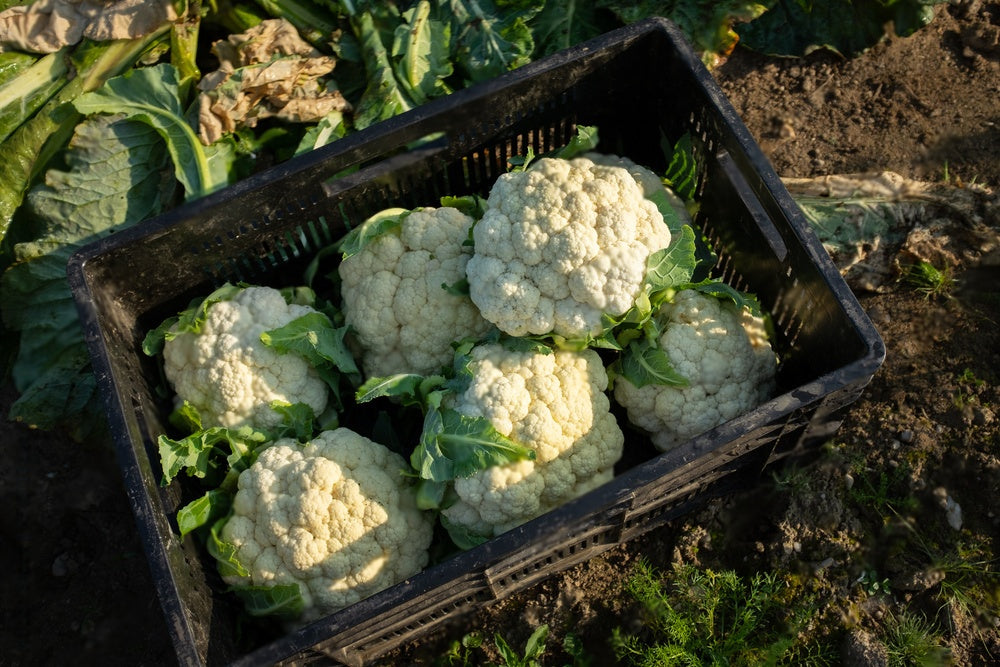
Grow Cauliflower in Pakistan: Moji Mall Guide
Share
Growing cauliflower (گوبھی) at home is easier than it seems — with the right season, steady care, and a few smart tips, you can enjoy fresh, creamy gobhi right from your garden or rooftop. Here’s a simple guide to walk you through every stage, perfect for Pakistan’s climate.
| Aspect | Details |
|---|---|
| Best Sowing Time | Mid-September to Early November (Plains), May–June (Cooler Areas) |
| Ideal Temperature | 15°C to 25°C |
| Germination Time | 5–10 days |
| Transplant Time | 3–4 weeks after sowing (4–5 true leaves) |
| Spacing | 18–24 inches between plants |
| Harvest Time | 75–90 days after transplanting |
Step 1: Sow Seeds 🌱
When to Sow:
- Sow seeds mid-September to early November in plains regions like Lahore, Karachi, and Islamabad, when temperatures start cooling.
- In cooler hill stations like Murree and Abbottabad, sow between May and June when weather is mild.
- The ideal temperature for sowing is 15°C to 25°C during the day.
- Late sowing risks exposing the crop to heat stress, leading to small or loose heads.
How to Sow: Fill seed trays or small pots with cocopeat and vermicompost. Sow seeds about 0.25 inch deep, cover lightly with soil, and mist gently with water.
Germination Tips: Place trays in bright, indirect sunlight. Sprouts usually appear in 5–10 days. If nights are cold, cover trays loosely with plastic to retain warmth and encourage faster sprouting.
Step 2: Transplant Seedlings 🌿
When to Transplant: Move seedlings when they grow 4–5 true leaves, usually around 3–4 weeks after sowing.
How to Transplant: Transplant into 12–14 inch pots or directly into garden beds. Space plants 18–24 inches apart to allow proper head development.
Aftercare: Transplant late in the afternoon or on a cloudy day to avoid transplant shock. Mix a handful of vermicompost into the soil and water thoroughly after moving the seedlings.
Step 3: Care for Plants 🌞💧
Sunlight Needs: Provide 6–8 hours of sunlight daily. If afternoons are very hot, offering partial shade helps prevent stress.
Watering: Water deeply 2–3 times a week, adjusting based on weather. Check soil moisture by inserting a finger 1 inch deep — water when it feels dry.
Feeding Schedule: Start feeding with NPK 20-20-20 fertilizer (1 teaspoon per liter of water) every 15 days after two weeks of transplanting. Switch to NPK 5-15-45 once heads start forming to encourage tight, strong heads.
Step 4: Protect Plants 🐛
Common Pests: Watch for cabbage worms, aphids, and white butterflies laying eggs under the leaves.
Natural Protection: Spray plants every 10–15 days with a neem oil solution (1 teaspoon neem oil + 1 liter water + few drops of soap), focusing on the undersides of leaves.
Common Problems:
- Tiny Heads: Caused by late planting or heat stress — sow early during cooler months.
- Yellow Heads: Caused by strong sunlight — fold outer leaves over the heads for shading (blanching).
- Bolting (early flowering): Caused by heat — sow early with fresh seedlings.
Step 5: Harvest Heads 🌸
When to Harvest: Cauliflower is ready 75–90 days after transplanting when heads feel tight, heavy, and creamy white.
How to Harvest: Use a sharp knife to cut the head cleanly, leaving a few protective outer leaves. Harvest early in the morning for best freshness.
Bonus Tip: After harvesting the main head, healthy plants may produce smaller side heads. Keep watering to enjoy a second mini-harvest.
FAQs
1. What should I do if my cauliflower plant grows leaves but no head?
This usually happens due to too much nitrogen, uneven watering, or late planting. Switch to a lower nitrogen fertilizer like NPK 5-15-45 and maintain steady moisture.
2. How can I protect cauliflower heads from birds or harsh sunlight?
Fold outer leaves over the forming heads to shade them naturally. Use garden netting if birds are causing damage.
3. Why are my cauliflower heads loose and leafy instead of tight?
Loose heads often result from heat stress or inconsistent watering. Early planting and maintaining steady moisture help develop tight heads.
4. Can I reuse the soil after harvesting cauliflower?
Yes, but refresh the soil by adding compost. It’s better to rotate crops and grow something different like leafy greens afterward.
5. Should I cut down the whole plant after harvesting the main head?
No need immediately. If the plant stays healthy, it can produce smaller side heads for additional harvests.
Growing cauliflower at home is all about good timing, steady care, and paying attention to small signs early. With a little patience and routine care, you’ll soon enjoy harvesting fresh gobhi — sweeter, healthier, and more satisfying than anything from the market.

